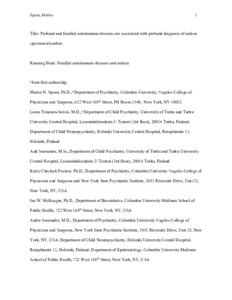Proband and Familial Autoimmune Diseases Are Associated With Proband Diagnosis of Autism Spectrum Disorders
Spann M.; Timonen-Soivio L.; Suominen A.; Cheslack-Postava K.; McKeague I.; Sourander A.; Brown A.
https://urn.fi/URN:NBN:fi-fe2021042824340
Tiivistelmä
Objective: There is evidence that parental autoimmune diseases (ADs) are associated with autism spectrum disorders (ASD) in offspring. The association between offspring ASD and ADs diagnosed in siblings and probands remains less clear. We examined whether proband and familial diagnoses of ADs were associated with increased odds of ASD in probands.
Method: The study is based on a nested case-control design that used data from a large national birth cohort (N = 1.2 million) in Finland. There were 4,600 cases of ASD and controls matched 1:4 on date of birth, sex, and residence. Data were accessed from national medical, birth, and central registries.
Results: Probands had a statistically significant increase in odds of ASD when they (adjusted odds ratio [OR] = 1.2), their mother (adjusted OR = 1.1), or their sibling (adjusted OR = 1.2) were diagnosed with an AD. With regard to specific ADs, we found a statistically significant increase in odds of ASD in probands diagnosed with autoimmune thyroiditis (adjusted OR = 2.7). Further analyses considering ADs by body system yielded a statistically significant increase in odds of ASD in probands with ADs associated with the central/peripheral nervous (adjusted OR = 4.8) and skin/mucous membrane (adjusted OR = 1.3) systems. Probands of mothers diagnosed with ear/eye (adjusted OR = 1.6) or respiratory (adjusted OR = 1.4) ADs, or siblings diagnosed with skin/mucous membrane ADs (adjusted OR = 1.3) also had increased odds of ASD.
Conclusion: The findings suggest that there may be common pathogenic, developmental mechanisms related to autoimmunity that are associated with the etiology of ASD.
Kokoelmat
- Rinnakkaistallenteet [27094]
